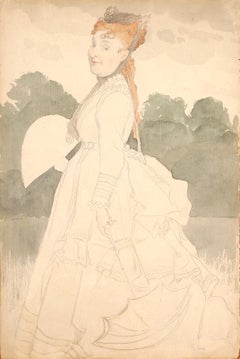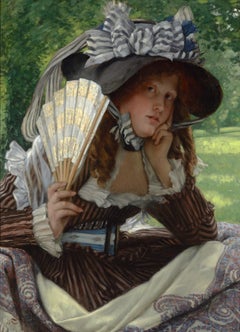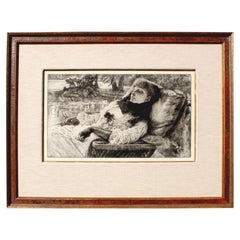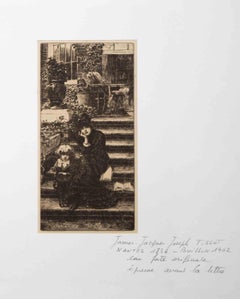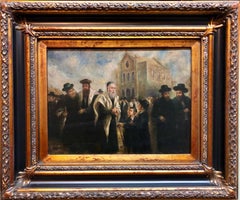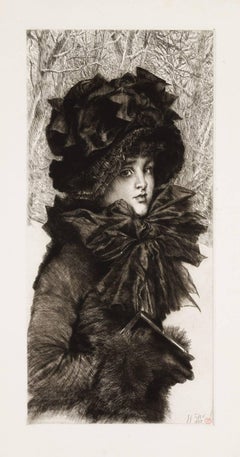James Tissot Art
French, 1836-1902
James Jacques Joseph Tissot (October 15, 1836 - August 8, 1902) was a French painter. Tissot was born at Nantes. He studied at the Êcole des Beaux-Arts in Paris under Ingres, Flandrin and Lamothe, and exhibited in the Paris Salon for the first time at the age of twenty-three. In 1855 Tissot moved to Paris where he studied under Jules-Élie Delaunay, Louis Lamothe and Hippolyte Flandrin. Lamothe, who had been a pupil of Ingres, introduced him to Edgar Degas. The two men became close friends. Another friendship formed at this time was with James McNeill Whistler. Two portraits, including one of Tissot's mother, were among the artist's first exhibits at the Paris Salon in 1859. In 1861 he showed The Meeting of Faust and Marguerite, which was purchased by the state for the Luxembourg Gallery. His first characteristic period made him a painter of the charms of women. Demi-mondaine would be more accurate as a description of the series of studies that he called La Femme à Paris.
Tissot fought in the Franco-Prussian War, and, falling under suspicion as a Communard, left Paris for London. Here he studied etching with Sir Seymour Haden, drew caricatures for Vanity Fair, and painted portraits as well as genre subjects. Sometime in the 1870s Tissot met a divorcée, Mrs. Kathleen Newton, who became his muse and the model for many of his paintings.(Biography provided by Allinson Gallery, Inc.)
to
2
5
3
8
6
3
1
Querelle d'amoureux. (Quarreling). 1
By James Tissot
Located in Storrs, CT
En plein soleil. (In the Sunlight). 1881. Etching and drypoint. Tissot 54, Béraldi 45, Wentworth 54. 7 13/16 x 11 1/2 (sheet 11 1/4 x 15). Edition about 100. Mat line and two hinge s...
Category
19th Century Impressionist James Tissot Art
Materials
Drypoint, Etching
Portrait of Lady Eugène Pegg walking in Saint Germain park (Paris)
By James Tissot
Located in BELEYMAS, FR
James TISSOT
(Nantes 1836 – Chenecey-Buillon 1902)
Madame Eugène Pegg walking at Saint Germain
H. 49 cm; L. 32 cm
Watercolor over pencil lines
Titled, located and dated on the back
...
Category
1870s French School James Tissot Art
Materials
Paper, Charcoal, Watercolor
Jeune femme à l’éventail (Young Girl with a Fan)
By James Tissot
Located in New Orleans, LA
Conjuring the brilliance of late 18th-century costume with infusions of 19th-century modernity, James Jacques Joseph Tissot’s Jeune femme à l’éventail illustrates the remarkable technique for which he was renowned. His delicate portraiture, combined with his fascination with conveying texture, demonstrates why he was one of the most revered artists of the Belle Époque.
Grouped with Tissot’s “keepsake pictures” of beautiful women in fashionable dress, this work is noteworthy not only for the fresh face of its sitter but also for the appearance of some of Tissot’s most beloved props. The delicate fan and paisley cashmere shawl, a favorite prop of Tissot’s artistic idol Jean Auguste Dominique Ingres, made frequent appearances in his paintings, as did the exquisite dress the sitter wears. Its identifiable styling can be seen in several of Tissot’s most notable works of the period, including La chéminée and Un déjeuner à la riviere.
The playful feel of this painting is grounded by Tissot’s exceptional attention to detail. A master of conjuring an array of textures, Tissot showcased this ability in this composition by juxtaposing many types of fabrics and patterns within one costume. This intricacy, which he carried even to his depiction of the woman’s manicure and jewelry, set him on par with the best artists of his day and contributed to his commercial success.
Born in 1836 in the port town of Nantes, Tissot traveled to Paris at the age of 20 in order to join the studios of Hippolyte Flandrin...
Category
19th Century Realist James Tissot Art
Materials
Panel, Oil
James Jacques Joseph Tissot "Soirée d'été" 'Summer Evening' Etching & Dry Point
By James Tissot
Located in Los Angeles, CA
A fine French 19th century etching and drypoint Titled "Soirée d'été" (Summer Evening) by Jacques Joseph Tissot (French, 1836-1902) depicting Mrs. Kathleen Newton resting on a lounge chair. Signed and dated (l/l): J.J. Tissot, 1881 in the plate. Under the mat, the front of the sheet inscribed in pencil with a '1' in a circle, the verso of the sheet with old price inscription "450-" in pencil. Circa: 1881-1882.
Measures: Plate Height: 9 inches (22.9 cm)
Plate Width: 15 1/2 inches (39.4 cm)
Sheet Height: 14 1/2 inches (36.8 cm)
Sheet Width: 20 5/8 inches (52.4 cm)
Frame Height: 19 inches (48.3 cm)
Frame Width: 24 1/2 inches (62.2 cm)
Frame Depth: 1 1/8 inches (2.9 cm)
Literature:
Wentworth 56. Note: Tissot's from 1881 is said to depict his lover, the Irish divorcee Mrs. Kathleen Newton, resting on a lounge chair.
Provenance:
Private collection, Los Angeles, California
Jacques Joseph Tissot (French, 15 October 1836 – 8 August 1902), Anglicized as James Tissot, was a French painter and illustrator. He was a successful painter of Paris society before moving to London in 1871. He became famous as a genre painter of fashionably dressed women shown in various scenes of everyday life. He also painted scenes and characters from the Bible.
Jacques Tissot was born in the city of Nantes in France and spent his early childhood there. His father, Marcel Théodore Tissot, was a successful drapery merchant. His mother, Marie Durand, assisted her husband in the family business and designed hats. A devout Catholic, Tissot's mother instilled pious devotion in the future artist from a very young age. Tissot's youth spent in Nantes likely contributed to his frequent depiction of shipping vessels and boats in his later works. The involvement of his parents in the fashion industry is believed to have been an influence on his painting style, as he depicted women's clothing in fine detail. By the time Tissot was 17, he knew he wanted to pursue painting as a career. His father opposed this, preferring his son to follow a business profession, but the young Tissot gained his mother's support for his chosen vocation. Around this time, he began using the given name of James. By 1854 he was commonly known as James Tissot; he may have adopted it because of his increasing interest in everything English.
In 1856 or 1857, Tissot travelled to Paris to pursue an education in art. While staying with a friend of his mother, painter Elie Delaunay, Tissot enrolled at the Ecole des Beaux-Arts to study in the studios of Hippolyte Flandrin and Louis Lamothe. Both were successful Lyonnaise painters who moved to Paris to study under Jean-Auguste-Dominique Ingres. Lamothe provided the majority of Tissot's studio education, and the young artist studied on his own by copying works at the Louvre, as did most other artists of the time in their early years. Around this time, Tissot also made the acquaintance of the American James McNeill Whistler, and French painters Edgar Degas (who had also been a student of Lamothe and a friend of Delaunay), and Édouard Manet.
In 1859, Tissot exhibited in the Paris Salon for the first time. He showed five paintings of scenes from the Middle Ages, many depicting scenes from Goethe's Faust. These works show the influence in his work of the Belgian painter Henri Leys (Jan August Hendrik Leys), whom Tissot had met in Antwerp earlier that same year. Other influences include the works of the German painters Peter Von Cornelius and Moritz Retzsch. After Tissot had first exhibited at the Salon and before he had been awarded a medal, the French government paid 5,000 francs for his depiction of The Meeting of Faust and Marguerite in 1860, with the painting being exhibited at the Salon the following year, together with a portrait and other paintings.
Émile Péreire supplied Tissot's painting Walk in the Snow for the 1862 international exhibition in London; the next year three paintings by Tissot were displayed at the London gallery of Ernest Gambart.
In about 1863, Tissot suddenly shifted his focus from the medieval style to the depiction of modern life through portraits. During this period, Tissot gained high critical acclaim, and quickly became a success as an artist. Like contemporaries such as Alfred Stevens and Claude Monet, Tissot also explored Japonisme, including Japanese objects and costumes in his pictures and expressing style influence. Degas painted a portrait of Tissot from these years (Metropolitan Museum of Art, New York), in which he is sitting below a Japanese screen hanging on the wall.
Still on Top, 1873
Tissot fought in the Franco-Prussian War as part of the improvised defense of Paris, joining two companies of the Garde Nationale and later as part of the Paris Commune. His 1870 painting La Partie Carrée (The Foursome) evoked the period of the French revolution. Either because of the radical political associations related to the Paris Commune (which he was believed to have joined mostly to protect his own belongings rather than for shared ideology), or because of better opportunities, he left Paris for London in 1871. During this period, Seymour Haden helped him to learn etching techniques. Having already worked as a caricaturist for Thomas Gibson Bowles, the owner of the magazine Vanity Fair, as well as exhibited at the Royal Academy, Tissot arrived with established social and artistic connections in London. Tissot used...
Category
Late 19th Century French Victorian Antique James Tissot Art
Materials
Glass, Wood, Paper
Girl and Child - Etching by James Tissot - Late 19th Century
By James Tissot
Located in Roma, IT
Girl and Child is an original Modern artwork realized by James Tissot, in full James-Joseph-Jacques Tissot, (born Oct. 15, 1836, Nantes, France—died Aug. 8, 1902, Buillon Abbey, near...
Category
Late 19th Century Modern James Tissot Art
Materials
Etching, Paper
Promenade dans la Neige - Etching by J. Tissot - 1880
By James Tissot
Located in Roma, IT
Beautiful print on verge crème, 2° state on 3, with letters printed in red. Stamp “Lugt 1545”.
Little crack and fold on lower left margin of the sheet.
Some small traces of oxidati...
Category
1880s Post-Impressionist James Tissot Art
Materials
Drypoint, Etching
On the Grass - Etching and Drypoint by J. Tissot - 1880
By James Tissot
Located in Roma, IT
Very fine print on verge crème.
Some small traces of oxidation, dust and some flowerings on external edges of sheet, otherwise excellent conditions.
Full margins.
Ref. Wentworth 50.
Category
1880s Post-Impressionist James Tissot Art
Materials
Drypoint, Etching
Le Matin - Etching by James Tissot - 1886
By James Tissot
Located in Roma, IT
Wonderful mezzotint and etching on China paper applied. The inscription reads: "Le matin/ J. J. Tissot Sc. et ex. 1886". Titled, signed and dated on plate on the lower margin, below ...
Category
1880s Modern James Tissot Art
Materials
Etching, Aquatint
Related Items
Untitled: Head of A Woman 2
By George Zachary Constant
Located in New York, NY
George Zachary Constant (American/Greek 1892-1978), "Untitled: Head Of A Woman No. 2", Portrait/ Figurative Etching and Drypoint signed on Paper, 12.50 x 8.75 (15.25 x 11.50 Framed),...
Category
Early 20th Century Modern James Tissot Art
Materials
Etching, Drypoint
Judaica "The Rebbe's Visit" European Hasidic Rabbi Oil Painting
Located in Surfside, FL
Realistic portrait of an older rabbi visiting and blessing a child in a European marketplace. Here the artist conveys a sense of quiet grandeur th...
Category
20th Century Realist James Tissot Art
Materials
Oil, Panel
1950's Modernist Painting - Portrait Of Figure On Gold
By Bernard Labbe
Located in Cirencester, Gloucestershire
Gold Man
by Bernard Labbe (French mid 20th century), stamped verso
original watercolour/gouache painting on paper
overall size: 111.75 x 8.5 inches
condition: very good and ready to...
Category
Mid-20th Century Modern James Tissot Art
Materials
Gouache, Watercolor
The Box at 'Faustus'
By Diana Thorne
Located in Storrs, CT
The Box at 'Faustus'. 1929. Drypoint. 11 x 8 7/8. Edition 100, #39. Signed, titled, and numbered in pencil. A rich impression printed on the full sheet of pale blue/green-toned wove paper. Signed in pencil. A tongue-in-cheek image of the devil in the opera box...
Category
1920s American Modern James Tissot Art
Materials
Etching, Drypoint
Self Portrait
By Augustus Edwin John
Located in Storrs, CT
Self Portrait. 1920. Etching and drypoint. Dodgson 138. 6 1/8 x 5 (sheet 13 1/4 x 11). Edition 105. A rich impression with plate tone, printed on cream wove paper. Slight toning in ...
Category
Early 20th Century Modern James Tissot Art
Materials
Drypoint, Etching
Comanche Dance, Ildefonso Pueblo, New Mexico Southwest Framed Etching
By Gene Kloss
Located in Denver, CO
Comanche Dance at San Ildefonso Pueblo (New Mexico). Etching and drypoint, artist's proof from an edition of 50 prints. Presented in a custom frame, outer dimensions measure 22 ¼ x 18 ½ x ½ inches. Image size is 11 ¾ x 14 ½ inches.
Print is clean and in very good vintage condition - please contact us for a detailed condition report.
Expedited and international shipping is available - please contact us for a quote.
About the Artist:
Gene (Alice Geneva) Kloss is considered one of America’s master printmakers. She was born in Oakland, California and established herself as an artist on the West coast.
Kloss was introduced to etching by Perham Nahl while at UC Berkley. She graduated in 1924, and in 1925 married poet Phillips Kloss. In her late twenties, Kloss moved to Taos, New Mexico and began her life’s work of the New Mexican landscape and peoples. It was at this time that she received national acclaim.
Her artwork exudes an unmistakable content and style. Enchanted by the architecture, mountainous landscapes and rituals of the inhabitants, Kloss captured the beauty of the Southwest and surrounding areas. Her style was bold yet deftly simple, masterfully expressing the elusive Southwestern light...
Category
1980s American Modern James Tissot Art
Materials
Drypoint, Etching
H 22.25 in W 18.5 in D 0.5 in
Olliver St. John Gogarty
By Gerald Leslie Brockhurst
Located in Storrs, CT
Oliver St. John Gogarty. 1935. Etching. Fletcher 78. 6 7/8 x 5 1/2 (sheet 11 1/4 x 8 3/8). Edition 100. 75 intended for the Cuala Press, Dublin. A rich impression, printed on cream-...
Category
Mid-20th Century Modern James Tissot Art
Materials
Drypoint, Etching
Untitled - Original Etching and Drypoint by Eugène Corneau - 1930s
By Eugene Corneau
Located in Roma, IT
Untitled is an original artwork realized by Eugène Corneau in the first years of the 1930s. Etching and drypoint on paper. Monogram of the artist on the lower left. Excellent conditi...
Category
1930s Modern James Tissot Art
Materials
Drypoint, Etching
H 9.85 in W 12.6 in D 0.04 in
Street in Smyrna
By Marius Bauer
Located in Storrs, CT
Street in Smyrna. 1889. Etching. Wisselingh 34. 7 x 5 1/4 (sheet 12 7/8 x 8 7/8).Edition 100, number 49. A rich, tonal impression printed on Strasbourg cream laid paper on the full s...
Category
Late 19th Century Old Masters James Tissot Art
Materials
Drypoint, Etching
Trio of English William Hamilton Neoclassical Engravings
By Sir William Hamilton
Located in Rio Vista, CA
Interesting trio of English Sir William Hamilton Greco-Roman neoclassical hand-colored engravings set of images made in the Grand Tour style. Hamilton was a British ambassador to the...
Category
19th Century English Neoclassical Antique James Tissot Art
Materials
Glass, Wood, Paper
Janine
By Arthur William Heintzelman
Located in Storrs, CT
9 5/16 x 8 1/4 (sheet 15 1/4 x 12 3/4). Toning in the image; otherwise good condition. A rich impression with plate tone printed on cream wove paper. Signed in pencil. Housed in a 20...
Category
Mid-20th Century American Modern James Tissot Art
Materials
Drypoint, Etching
Giovanni Piranesi Etching of Ancient Roman Architecture, 18th Century
By Giovanni Battista Piranesi
Located in Alamo, CA
"Veduta del Sepolcro della Famiglia Plauzia per la Strada Che Conduce da Roma a Tivoli vicino a Ponte Lugano" from "Le Antichità Romane" (Roman Antiquities), one of the most famous works by Piranesi. "Antichita" illustrates the tombs along the Appian Way...
Category
Early 18th Century Old Masters James Tissot Art
Materials
Drypoint, Engraving, Etching
H 24.38 in W 31.75 in D 0.75 in
Previously Available Items
Sunday Morning
By James Tissot
Located in San Francisco, CA
Original etching and drypoint printed in black ink on laid paper
Signed and dated in the plate lower right J.J. Tissot / 1883.
A superb, richly printed impression of the definitive...
Category
1880s Victorian James Tissot Art
Materials
Etching
En plein soleil. (In the Sunlight).
By James Tissot
Located in Storrs, CT
En plein soleil. (In the Sunlight). 1881. Etching and drypoint. Tissot 54, Béraldi 45, Wentworth 54. 7 13/16 x 11 1/2 (sheet 11 1/4 x 15). Edition abo...
Category
19th Century Impressionist James Tissot Art
Materials
Drypoint, Etching
James Tissot art for sale on 1stDibs.
Find a wide variety of authentic James Tissot art available for sale on 1stDibs. You can also browse by medium to find art by James Tissot in etching, drypoint, engraving and more. Much of the original work by this artist or collective was created during the 19th century and is mostly associated with the Post-Impressionist style. Not every interior allows for large James Tissot art, so small editions measuring 4 inches across are available. Customers who are interested in this artist might also find the work of Paul Cézanne, Auguste Lançon, and Charles Joshua Chaplin. James Tissot art prices can differ depending upon medium, time period and other attributes. On 1stDibs, the price for these items starts at $2,031 and tops out at $885,000, while the average work can sell for $4,063.
Artists Similar to James Tissot
Questions About James Tissot Art
- Was James Tissot catholic?1 Answer1stDibs ExpertApril 5, 2022Yes, the noted painter James Tissot was a devout Catholic. It’s believed that he developed his religious devotion because of his mother’s convictions and beliefs. His best known works typically display women in very fashionable clothing of the era. On 1stDibs, find a variety of original artwork from top artists.
